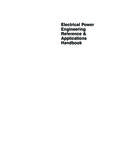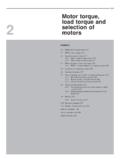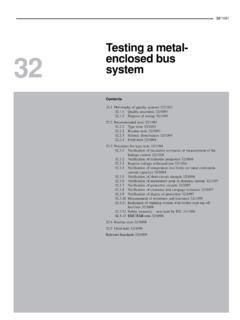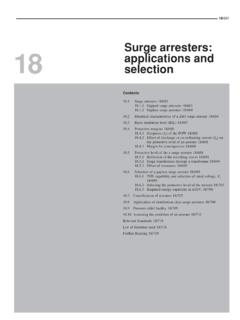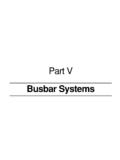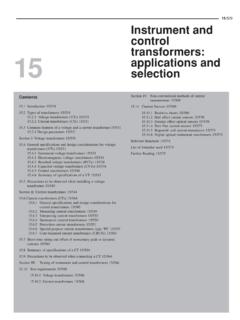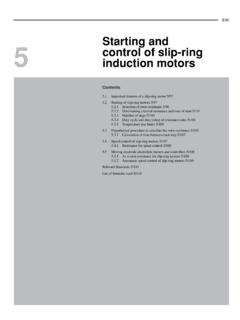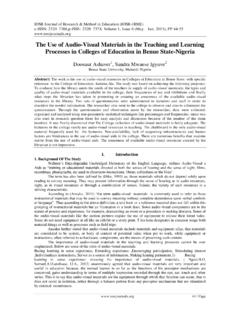Transcription of Contents
1 Phase bus (IPB) system 31 Main run and auxiliary feed lines 31 Instrumentation and protection connections 31 Shorting of phase enclosures 31 features 31 Non-continuous or insulated enclosures 31 Continuous or bonded enclosures 31 features of an IPB system 31 heating 31 Skin effect in a tubular conductor 31 Thickness of enclosure 31 Proximity effect in an IPB system 31 Solar radiation 31 cooling of enclosures 31 rating 31 cooling 31 of space field on metallic structures 31 level 31 Voltage drop 31 sections for IPB system 31 Determining the section and size of conductor and enclosure 31 Sample calculations 31/1085 Relevant Standards 31/1089 List of formulae used 31/1089 Further Reading 31/109031An isolated phasebus system31/1067An isolated phase bus system31 Isolated phase bus (IPB)systemIn this construction the conductors of each phase arehoused in a separate non-magnetic metallic enclosure toisolate them completely from each other with the followingobjectives.
2 1It eliminates phase-to-phase eliminates the proximity effect (extra forces andheating) by providing a magnetic shielding to thesupporting and metallic structures in the reduces the proximity effects between the maincurrent-carrying conductors of the adjacent phases toalmost zero due to magnetic shielding and large provides complete protection for operating personnelfrom high touch or step voltages (for details seeSection ) across the enclosure and the metallicstructures caused by parasitic (electromagnetic) bus system is easy to handle, bend and is used for HV systems of very large it is a more expensive arrangement it is normallypreferred only for critical installations such as a powergenerating station, where it has to carry large to verylarge currents due to high ratings of the generating a thermal power plant it is used between the generatingunit (G) and the generator transformer (GT) and the unitauxiliary transformers (UATs) and sometimes betweenthe UAT and the unit HV switchgear as illustrated inFigure (redrawn in Figure for more clarity).
3 A typical layout of such a bus system in a thermal powerplant is illustrated in Figure (a) and (b). It maycomprise sections noted in Section insulated busbars (GIB) The above features wouldbe easily possible in an SF6 bus systems also but thatbeing a costlier arrangement is usually not , when required at locations having spaceconstraints or other hindrances such as within a powergenerating station, such bus systems are an immediatesolution. Also see Section Main run and auxiliary feed lines1 From generator phase terminals to the lower voltageside of the GT. This section may partly be indoors,connecting the generator inside the turbine room andpartly outdoors, connecting the GT in the generator neutral bus to form the generator star with tee joints from the main run to the from UAT secondaries to the unit the GT is made of three, single-phase transformers,an inter-connecting IPB will be required to form thedelta as illustrated in Figure (b).
4 Instrumentation and protectionconnectionsSince an IPB forms an important integral part of a power-generating station, with it are associated a number ofmetering and protective devices such as CTs, VTs andgenerator grounding system. Below we identify inter-connections that may be required to connect these CTsand VTs while installing an IPB links for easy mounting and maintenanceof CTs for metering and protection, typically as each phase in the main lines between the generatorand the GT, 1 CT for meteringTransformeryardOutdoorinstallati onPower house areaIndoorinstallationTap-offconnectionG eneratortransformer(GT)To switch yardTee jointsTap-offconnectionUnit auxiliarytransformer-2(UAT-2)Unit bus ductSealing offchamberGeneratorUnit auxiliarytransformer-1(UAT-1)Unit bus breaker33 kV/11 breaker33 kV/11 kV Three phase two wind-ing transformer (UAT) Three phase two wind-ing transformer with ONload tap changer (GT)
5 Circuit breakerBus duct passingthrough the wallFigure of an IPBP ower house wall31/1070 Electrical Power Engineering Reference & Applications Handbook 1 CT for protection 1 CT for AVR (automatic voltage regulator) 1 CT for differential protectionNoteFor measuring purposes non-conventional Rogowskicoils (Section ) can be each phase on the neutral side, 1 CT for differentialprotection, two sets of three CTs each for metering,in the tap-offs for the two UATs and two sets of threeCTs each for protection in the tap-offs for the two with a neutral CT, from star point of thegenerator, to the neutral grounding transformer (NGT).3 VTs and surge protection tap-offs for each phase fromthe main run, for metering and surge other connections, that may be necessary at siteor additional CTs for Shorting of phase enclosuresFor continuous enclosure IPBs, the following ends ofthe enclosures are shorted to ensure continuous flow ofinduced currents: At the generator end, as near to the generator terminalsas possible.
6 GT ends, as near to the transformer flanges as possible. UAT ends. Both sides of the neoprene or EPDM rubber or metallicexpansion bellows (Figure (a)). Near the generator neutral terminal. Any other section, where it is felt that it is not properlybonded and the induced currents may not have acontinuous enclosure, however, should be insulated at all suchlocations, where the IPB terminates with anotherequipment, such as at the generator, GT, UATs, VTs, andthe NGT to avoid longitudinal currents through suchequipment as shown in Figure (b). These equipmentsare grounded Constructional featuresAs discussed later, the enclosure of an IPB may carryinduced currents up to 95% of the current through themain conductors. Accordingly, the enclosure is designedto carry longitudinal parasitic currents up to 90 95% ofthe rated current of the main busbars.
7 The cross-sectionalarea of the enclosure is therefore maintained almost equalto and even more than the main conductors to accountfor the dissipation of heat of the main conductors alsothrough the enclosure only, unless an additional forcedcooling system is adopted. The outdoors part of theenclosure exposed to atmospheric conditions is alsosubjected to solar radiation. Provision must be made todissipate this additional heat also, from the main bus and its enclosure is normally in a tubularform, in view of the inherent advantages of a tubularFigure (a)Layout of 24 kV, 20 kA isolated phase bus duct from generator to generator transformer for NTPCN eutralgroundingtransformerGrating/concre te floorVTS & surgeprotectioncubicleBellows assemblywith seal offbushingTap-OFFSfor UATSB ellowsassemblyGT flangeGeneratortransformerTransformer yardTurbine roomCL of turbo generatorCL of turbo generatorGeneratorflangeSpringelementInd oorOutdoorSealingoff chamberMetallic bellowsassemblyRYBP owerhousewallAn isolated phase bus system31/1071section, as discussed already (concentration of current inthe annulus, Section ).
8 One more advantage of atubular section is that it exerts equal forces at all pointsof the enclosure and relieves it and the conductor fromany undue stresses. Octagonal and hexagonal sectionsare also used as they also have near-symmetry. Insulating medium: Dry air or SF6 gas Insulators: The conductors are resilient mounted onpost insulators, to hold them in the centre ( ) and dampen the forces, during normal operationor on fault. The conductors are held in position tohave free movement axially but they have almost nomovement radially. The thermal effects of theconductors are taken care of by the expansion joints(Figure (a)) and those of the enclosure by thebellows (Figure (b) and (c)). For termination seeFigure (d). Nominal current ratings: Some typical current ratingsfor the stator voltages considered in Table are10 000 A for a 250 MVA generator to 40 000 A for a1000 MVA generator.
9 (See item 3 of the table for thenormal current ratings for different MVA ratings andstator voltages of generators.) The preferred ratingsmay follow series R-10 of IEC 60059 as in (4).RYBHV side400 kV ( )LV side ( )Generator transformer (GT)(arrangement illustrates when3,1-f transformers are used)Enclosure shorting pointsMetering CTsIPB tap-offsUAT-2 Unit switchgearCubicle for VTs* andsurge protectionEnclosure shorting pointsA little distance away tobe out of IPB proximityarea on a ground faultStator neutral groundingtransformer (NGT)= Gen. voltage3 GFF Neutral groundingtransformer with enclosureV240 V**Secondaryloading resistorNCTStar pointGeneratorneutral busCTs for differentialprotectionGeneratorNa1b1c1a2 b2c2 RYBLine sideCTs fordifferentialprotectionIPB tap-offsUnit switchgearCTs forAVRP rotectionCTsMeteringCTsProtectionCTsBend sMetering CTsIPB bends andinter-connectionsTee joints*It may be supplemented with a surge capacitor, to suppress the steepness of a and diminish its (Section )**TypicalUAT-1 Figure (b)Typical layout of an IPB system in a thermal power station, illustrating enclosure end shortings for continuousenclosures31/1072 Electrical Power Engineering Reference & Applications Handbook Types of enclosures.
10 These may be of two types, , and Non-continuous or insulated enclosuresThese were used until the early 1960s and have sincebeen discontinued in view of the inherent advantages ofa continuous enclosure. In non-continuous enclosuresthe individual sections that are added together to obtainthe required length and configuration of the bus layoutare electrically insulated from each other. They are alsoinsulated from their mounting structures by rubber orfibre-glass or similar insulating pads, as illustrated inFigures (a) and (b). This is to prevent the longitudinalflow of current from one section of the bus system to theother as well as from one phase enclosure to the is no external return path for the induced local induced currents do flow through each insulatedsection and may cause nominal step and touch section is grounded at one point (only) to its ownseparate ground bus which in turn is connected to thestation ground bus at one point only to make the inducedcurrent flow in one direction only.
